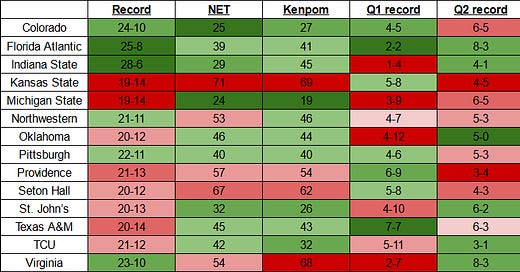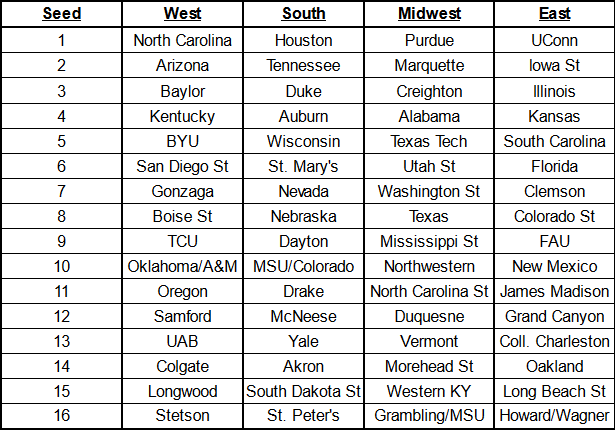Scott Bell's projected 2024 NCAA tournament bracket
This post is unlocked and available for all readers.
This seems like a weird exercise to be doing this season, since this is a Michigan-centric blog and the Wolverines’ only chance of being a part of March Madness action this year is if they buy a ticket to spectate. But I’ve done bracket projections (almost) every year since launching this newsletter, so I’d like to keep that rolling.
I didn't do it last spring because I was at Disney World with my family over spring break, but the two years before that I did do it (and did quite well), so I don’t want a poor season from Michigan to ruin what I’m hoping turns into an annual tradition in this space.
For the sake of transparency, here's how I did with the 2021 and 2022 projections:
2021 (full projection here): 67 of 68 (only miss: I had Saint Louis in; Utah St out)
2022 (full projection here): 67 of 68 (only miss: I had A&M in; Notre Dame out)
This year’s tournament is looking like it could be pretty juicy, especially with a very live bubble after a handful of bid steals took place on Saturday.
Here’s my breakdown of this year’s bubble, followed by which 68 teams I think will make it and how it’ll all take form on an actual bracket.
The bubble
After sorting through the candidates and adding in all of the automatic qualifiers, here’s how my bubble takes shape. I have seven spots for these 14 schools. Here's a grid that shows how they match up in key areas (schools are listed in alphabetical order):
Who gets in?
Florida Atlantic: The only school with all green on the grid gets in pretty comfortably in my book. And I promise this isn’t just me sucking up to Dusty May in an effort to curry favor from someone I hope is a key candidate for Michigan’s coaching opening.
Colorado: This is pretty close to a lock in my book, too. The Buffaloes had a chance to take all mystery out of the equation by winning the Pac-12 Championship on Saturday night. But they lost to Oregon and have to get in on their own merit. SOS might work against them, but NET, KenPom and Q1 record all are big pluses on their resume when measured up against the competition.
Northwestern: The Wildcats picked up wins over the Big Ten’s two top dogs this season — Purdue and Illinois — with wins over the likes of fellow tournament teams Nebraska, Dayton and (likely) Michigan State, too. The quality of those specific wins, coupled with the volume of 21 total Ws out of the Big Ten, should be enough.
TCU: The Horned Frogs didn’t have the best winning percentage in Q1 games by any means, but nobody faced a tougher schedule out of bubble teams, and winning 5 Q1 games should be enough to detract attention away from those 11 Q1 losses.
Texas A&M: The Aggies have far from a perfect resume. But 7 Q1 wins and a 7-7 Q1 record is such a superlative that it alone should be able to carry Texas A&M into The Dance.
Michigan State: There’s a lot of red on that grid, and 14 losses is a lot. But a team with those NET/Kenpom rankings has never been left out before, and it would be a pretty big shock if a program with Michigan State’s name brand value became the one to break that curse. A “neutral court” win over Baylor (in a game that took place in Detroit) can help drown out a lot of the red on that resume, too.
Oklahoma: The Sooners get the 68th and final spot in my bracket. I really went back and forth a lot with Oklahoma and St. John’s, but the respect the Big 12 has earned over the last few years (along with Oklahoma’s perfect record in Q2 games) ultimately serves as the tiebreaker here. But I’m far from confident this is how ti plays out.
Just missed:
St. John’s: This is my stone bubble. It would be wild to see a team with a NET of 32 and a KenPom of 26 be left out of the field. But if I match St. John’s up against the four schools I have in the play-in, they (barely) come out as the 5th of those five teams.
Indiana State: I really would have liked to see Indiana State get in there, because that’s the type of school that can make a run in the tournament and I feel like smaller-conference schools should get the nod over major conference teams that were middle of the road in their conferences. But ISU’s volume was much lower than everyone it’s competing against. Michigan State having a head-to-head win over the Sycamores is significant, too.
Virginia: In the past, a 23-10 team from the ACC getting left out of the field would be unheard of, especially one with a pedigree like Virginia. But the Cavaliers are at or near the bottom when it comes to Kenpom, Q1 performance and NET rating, so that name brand will only get them so far, especially after the Saturday night bid steals.
Seton Hall: The Pirates have some big wins, including victories over projected No. 1 seed UConn and No. 2 Marquette. But there’s a lot of red on that grid and the overall metrics just don’t measure up favorably to the competition.
Pitt: The Panthers aren’t getting a whole lot of love among bubble teams, but there’s a long of green on that grid. The ACC being down this year and Pitt not having one big resume piece to hang its hat on is enough to keep them out, though.
The teams
With the bubble sorted out, here are my 68 teams:
The bracket
And here’s how they all fit together on a bracket:
The contest
Just a heads up — I’ll be hosting my fourth annual subscriber NCAA Tournament contest once again this week. Look for details on that to come out either Monday or Tuesday. But once again, I plan on running two different contests: One for premium subscribers only with a $50 cash prize for whoever performs best. And one for premium/free subscribers with a free one-year premium subscription as the prize (if a premium subscriber wins this, they can either get a year tacked on to their existing subscription or a subscription they can gift to a friend).
Both are free to enter.






